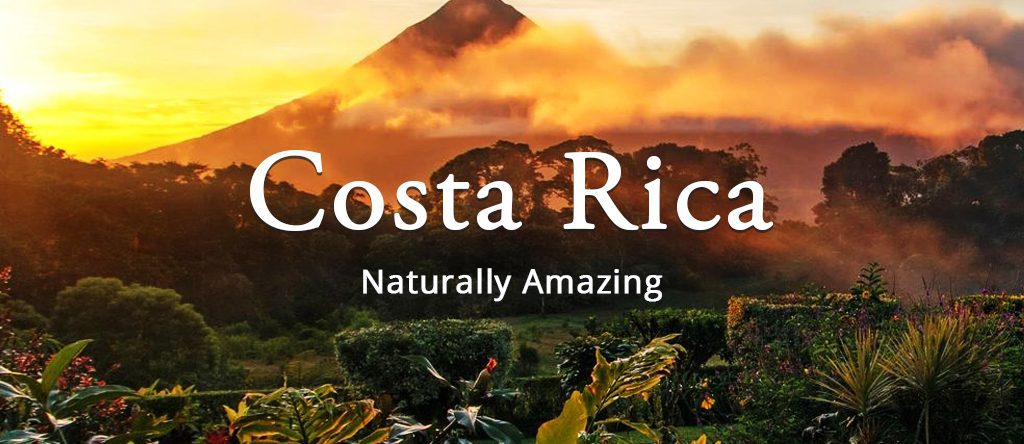Find your balance on a surfboard or a yoga mat, explore caverns filled with the echoes of bats, or climb the misty slopes of ancient volcanoes. Welcome to Costa Rica, where every moment invites you to relax and enjoy an unforgettable journey.
In this tropical paradise, volcanoes rise through the mists of lush jungles, and cinnamon-hued beaches border forests filled with the sounds of howling monkeys. Every step here is an adventure, leading you to new sights and experiences.
This travel guide to Costa Rica is your ultimate companion for a memorable vacation. It’s packed with practical tips, advice for planning your itinerary, and detailed explorations of must-visit places. We cover everything from the bustling streets of San José to the waves of Tamarindo and the mystical cloud forests of Monteverde.
So, let us discover the captivating destinations and activities that make Costa Rica a world-renowned travel destination.
Geographical and Cultural Overview of Costa Rica
Costa Rica has a rich history, which includes indigenous heritage, Spanish colonial influence, and a peaceful transition to democracy. Unlike many neighbors, the country abolished its army in 1949, redirecting national resources to education and healthcare. This pivotal moment, often remembered and honored during Costa Rica holidays, reflects the country’s commitment to peace and sets the stage for its modern identity.
Look at our article – A Brief History of Costa Rica– for a deeper dive into the country’s rich history and know why Costa Rica is Costa Rica.
Weather Patterns and Climate Zones of Costa Rica
Tucked between Nicaragua and Panama, Costa Rica is a jewel of Central America. Its compact size belies its incredible geographic diversity, from sun-kissed beaches to towering volcanoes and dense rainforests. The country boasts several climate zones, including the tropical coastlines and the cooler highlands, each supporting a unique ecosystem. This diversity is a paradise for nature lovers and adventurers, contributing to its status as one of the world’s most luxurious and eco-conscious vacation destinations.

When is the Best Time to Visit Costa Rica?
Choosing the right time to visit Costa Rica depends on your preferences for weather and activities. The tropical climate is one of the ten reasons highlighted in the article – why visit Costa Rica?
The country enjoys a distinct dry season from December to April, characterized by sunny and warm weather, ideal for beach vacations and exploring national parks.
The rainy season spans May to November, offering a lush, green landscape with frequent rain showers. Despite the rain, this season presents a unique charm and is often less crowded. The rainy season is the perfect option for those willing to explore the tropical natural beauty with fewer tourists and lower costs.
Regardless of the season, the diverse climate zones here cater to various interests, ensuring a memorable trip any time of the year. To decide when to visit based on specific activities or regions, refer to our detailed guide on the best time to visit Costa Rica.
| Month | Weather Pattern | Typical Weather |
| January | Dry Season | Sunny and warm |
| February | Dry Season | Sunny and warm |
| March | Dry Season | Sunny and warm |
| April | Dry Season | Sunny with occasional showers |
| May | Transition Month | Increasing rainfall |
| June | Rainy Season | Frequent rain showers |
| July | Rainy Season | Frequent rain showers |
| August | Rainy Season | Frequent rain showers |
| September | Rainy Season | Heaviest rainfall |
| October | Rainy Season | Heaviest rainfall |
| November | Transition Month | Decreasing rainfall |
| December | Dry Season | Sunny with occasional showers |
Costa Rica Travel Requirements
Before you pack your bags for the lush landscapes and vibrant culture of Costa Rica, it’s important to be aware of the essential travel requirements. Keeping these in mind ensures a smooth and hassle-free journey to this tropical paradise.
Visa and Entry Requirements
Are you traveling to Costa Rica? You’re in luck if you’re from the United States, Canada, or most European countries, as you won’t need a visa for stays up to 90 days. Just ensure you have a valid passport and a return ticket scheduled within those 90 days. For travelers from other countries, a visa might be required. Verifying the latest visa requirements with the Costa Rican embassy or consulate in your home country is crucial before your trip.
Health and Safety Tips
Costa Rica is a safe destination, but standard travel precautions apply. Stay current with vaccinations, including MMR (measles, mumps, rubella), diphtheria-tetanus-pertussis, chickenpox, polio, and the annual flu shot. Hepatitis A and Typhoid vaccines are also recommended, as there’s a risk of contaminated food and water. Keep an eye on travel advisories and COVID-19 vaccine requirements as well.
Don’t forget travel insurance. It’s a must-have for handling medical emergencies, trip cancellations, or lost belongings.
Currency, Payment, and Budgeting Tips
The local currency is the Colón (CRC), but you’ll find that U.S. dollars are accepted in many tourist spots. Credit cards work well in most hotels, restaurants, and bigger stores. However, carrying cash is a good idea, particularly in remote areas.
Regarding budgeting, Costa Rica caters to various spending levels. It’s pricier than its Central American neighbors, but with thoughtful planning, you can enjoy what it offers without breaking the bank. Embrace local dining, use public transportation, and indulge in free activities like beach visits and hikes to make the most of your budget.
Transportation Options in Costa Rica
Exploring the stunning landscapes and diverse attractions is an adventure in itself, and choosing the right mode of transportation enhances this experience. Travelers have various options to navigate the country, each offering a unique perspective of its natural beauty.
Let’s explore the most convenient ways to travel around Costa Rica.
Rental Cars
For those valuing freedom and flexibility, renting a car is a great choice. The country offers a wide selection of rental cars to suit various budgets and needs. Standard cars are perfect for well-paved routes, while a 4×4 is better suited for rugged terrains, particularly during the rainy season. You’ll find rental agencies at major airports and cities. However, booking ahead is recommended, especially in peak tourist times.
Public Transport
Public buses in Costa Rica are a cost-effective and reliable option for getting around. The bus network covers most towns and key tourist spots. While it might take longer than driving, traveling by bus lets you experience local life and is a more environmentally friendly choice. For longer distances, comfortable, air-conditioned coaches are available.
Domestic Flights
If time is of the essence, consider domestic flights. They connect major destinations such as Guanacaste, the Nicoya Peninsula, and the Southern Pacific region. Local airlines offer these routes, providing breathtaking views of the tropical landscapes. Keep in mind that luggage restrictions can be stringent, and flight schedules may vary with the weather.
Regardless of your choice, each transportation option in Costa Rica offers its own unique way to enjoy the country’s incredible scenery and culture.

How to Reach Costa Rica
Costa Rica is accessible from all corners of the globe. Whether flying in or embarking on a scenic road trip, the journey to this tropical paradise is as thrilling as the destination itself.
Let’s explore the best ways to reach Costa Rica.
By Air
Flying is the most convenient way to reach Costa Rica, with two primary airports serving international travelers:
- Juan Santamaría Airport (SJO): Nestled near San José, Costa Rica’s capital, this airport welcomes over 5.5 million visitors yearly. It connects Costa Rica to the United States, Europe, and other Central American countries. Its central location is perfect for starting your exploration, offering easy access to the Caribbean beaches, Pacific coastline, and mystical cloud forests.
- Guanacaste Airport (LIR): Also known as Liberia Airport, this facility in Guanacaste Province is increasingly popular, especially for those heading to the region’s famous surf spots and pristine beaches. Catering to around 1.1 million tourists annually, it connects Costa Rica with cities like London, Houston, and Los Angeles.
By Road
The Pan-American Highway offers a remarkable road trip for those seeking an overland adventure. Traversing over 18,640 miles, this route cuts right through the heart of Costa Rica. However, it’s a path for the adventure, featuring winding mountain roads and challenging terrains. Known locally as ‘Vía Muerta,’ the route demands experienced driving skills. The journey from San José to the U.S. border can span over 65 hours, presenting a once-in-a-lifetime road trip experience.
No matter your mode of arrival, traveling to Costa Rica is an adventure. Each option provides a unique perspective on the beauty and diversity of this captivating country.
What to Pack for Your Costa Rica Adventure?
Packing for Costa Rica involves preparing for varied activities and climates. Here’s a streamlined list to help you pack effectively.
Essentials for All Climates
- Lightweight, breathable clothing suitable for warm weather
- Comfortable walking shoes for city exploration and light hiking
- Rain gear, including a compact, waterproof jacket or poncho
- Sun protection with sunglasses, broad-spectrum sunscreen, and a wide-brimmed hat
- Insect repellent, crucial for jungle and rural areas
- Reusable water bottle to stay hydrated and eco-friendly
Beach and Coastal Areas
- Swimwear for enjoying beautiful tropical beaches
- Beach towel or sarong – quick-drying and space-saving
- Flip-flops for beachside comfort
- Snorkeling gear if you plan to explore underwater
Mountain and Rainforest Regions
- Warm layers for cool evenings, especially in higher elevations
- Waterproof hiking boots for rainforest treks and muddy trails
- Binoculars to enhance wildlife-watching experiences
- Dry bags to protect electronics and important documents from moisture
Miscellaneous
- Camera to capture breathtaking landscapes and wildlife
- Power adapter, as Costa Rica uses standard U.S. plugs and 110V electricity
- First-aid kit with personal medication and basic supplies
- Copies of important documents like passport, travel insurance, and vacation itinerary
Packing light is key for enjoying the laid-back lifestyle and natural beauty. This list ensures you have the essentials covered while leaving space for those unique Costa Rican souvenirs you might find.
Costa Rica Cuisine and Dining
Costa Rican cuisine celebrates flavors and health, a testament to the country’s rich agricultural heritage and diverse cultural influences. Tropical cuisine seamlessly blends traditional staples with fresh, locally sourced ingredients, creating dishes that are both flavorful and nourishing.
Our article on Costa Rica cuisine offers an in-depth look at the unique flavors and staples that characterize every dish. From the zesty tang of tropical fruits to the earthy richness of locally grown coffee beans, you’ll discover how the culinary scene here is deeply rooted in its natural bounty.
Costa Rica diet is the go-to resource for those interested in the healthy aspects of the local diet. It details the must-try dishes and beverages that are not only delicious but also embody the wholesome lifestyle of the region. This blog beautifully illustrates how Costa Rican cuisine contributes to a healthy, balanced diet.
If you’re a cafe enthusiast looking to explore the country’s vibrant coffee culture, Costa Rican cafes highlight the best spots for a truly authentic coffee experience.
In Costa Rica, dining isn’t just about eating; it’s a way to connect with the local culture, understand its traditions, and appreciate its commitment to health and sustainability. The articles above will give you in-depth knowledge about the tropical diet and cuisine.
The Top Places to Visit in Costa Rica
Costa Rica is a treasure trove of natural wonders and stunning destinations. While it’s challenging to narrow down the choices, here are some of the must-visit places:
- Manuel Antonio National Park: On Costa Rica’s Pacific coast, this park is famed for its beautiful beaches, lush rainforests, and coral reefs. It’s a hotspot for wildlife enthusiasts, offering sights of sloths, monkeys, and crabs. Activities like swimming, snorkeling, and kayaking let you immerse in the natural beauty. Don’t forget to book tickets and guides in advance for the best experience in Manuel Antonio.
- Arenal Volcano National Park: Located in northern Costa Rica, this park surrounds one of Central America’s most active volcanoes. Hiking trails offer diverse adventures, from volcanic cone views to the scenic Lake Arenal and the Tilaran mountain range.
- Tortuga Island: This slice of paradise features white-sand beaches and crystal-clear waters. Reachable only by boat, Tortuga Island is perfect for swimming, snorkeling, and relaxing. Book your Costa Rica tours in advance to ensure a hassle-free visit to this idyllic spot.
- Monteverde Cloud Forest Biological Preserve: A haven for nature lovers, Monteverde boasts an incredible variety of flora and fauna, including over 400 bird species. Hiking trails wind through this lush forest, so come prepared with appropriate footwear and a rain jacket. After exploring the forest, enjoy a local meal at Raices or buy souvenirs at The Naturalist Shop.
- Golfo de Nicoya (Las Catalinas): This charming beach town on the Pacific coast is known for its sustainability, white-sand beaches, and delicious dining options. Activities like swimming, kayaking, and windsurfing ensure an action-packed visit.
Each destination offers a unique glimpse into Costa Rica’s beauty and biodiversity. For more on Costa Rica’s rich array of attractions and activities, our article – Costa Rica travel itinerary for 10 days provides in-depth insights.
Activities to Enjoy in Costa Rica
Costa Rica is a playground for adventure seekers, nature enthusiasts, and culture lovers. Let’s explore the array of activities this vibrant country has to offer.
Adventure Activities: This country is a haven of adventure. From zip-lining through lush rainforests to hiking active volcanoes, the opportunities for adrenaline-pumping experiences are endless.
Water-based Activities: The crystal-clear waters of Costa Rica are perfect for a variety of water sports. Whether surfing on the Pacific Coast, snorkeling among vibrant coral reefs, or kayaking through tranquil mangroves, each experience brings you closer to the country’s aquatic wonders.
Cultural Experiences: From exploring local markets and historical sites to witnessing traditional festivals, the cultural experiences provide a deeper understanding of the country’s heritage and lifestyle. Refer to the article – The best places to visit in Costa Rica for cultural experiences for insights into enriching cultural journeys.
Local Customs and Etiquette in Costa Rica
Understanding and respecting local customs is key to a fulfilling travel experience in Costa Rica. Locals, AKA Ticos, are known for their warm hospitality and ‘Pura Vida’ lifestyle. Politeness and friendliness are valued, so a courteous greeting and a smile go a long way.
When visiting religious or cultural sites, dressing modestly and behaving respectfully is appreciated.
Environmental conservation is also a significant part of Costa Rican ethics; hence, being eco-conscious during your stay is crucial.
For a deeper understanding of social norms and practices, visit our article – The customs & etiquettes of Costa Rica.
Sustainable Tourism in Costa Rica
Costa Rica is a world leader in sustainable and regenerative tourism. The country’s commitment to preserving natural beauty and biodiversity is evident in its eco-friendly policies and practices. From conservation projects to community-based tourism, visitors have numerous opportunities to engage in travel that respects and nurtures the environment and local cultures.
To learn more about how Costa Rica is at the forefront of eco-conscious travel, check out our article on Costa Rica ecological tourism.

Where to Stay in Costa Rica?
Accommodation in Costa Rica ranges from budget-friendly hostels to luxurious villas, catering to all preferences and budgets. Eco-lodges and sustainable hotels are popular choices, aligning with the country’s dedication to environmental preservation.
Luxury villas in Costa Rica offer a more personalized experience for those seeking exclusivity and comfort, often featuring stunning locations and top-notch amenities. Explore various stay options to find the perfect fit for your travel style and needs for a comfortable and relaxing vacation option.
The Final Wrap-up
As we conclude this Costa Rica travel guide, we leave you with a reflection that captures the spirit of Costa Rica. This country invites you and your loved ones to a journey beyond the ordinary. Here, you don’t just encounter sights to see; you’re offered experiences that touch the soul and invigorate the spirit of all ages.
Costa Rica is ready to welcome your family with open arms. Whether it’s adventure-filled days or moments of serene beauty, may your family vacation in Costa Rica be as transformative as the land itself.








